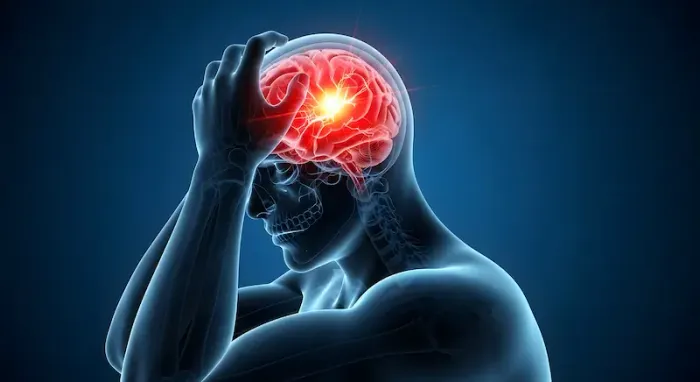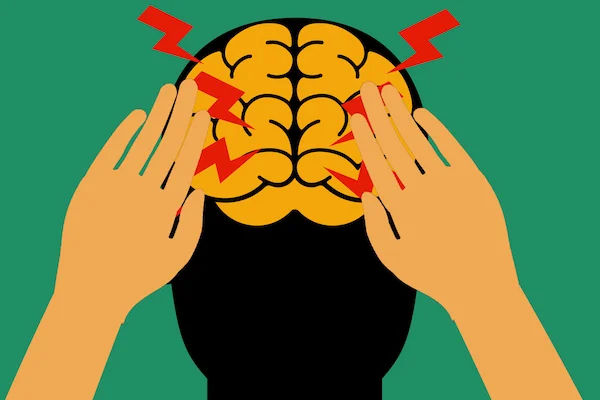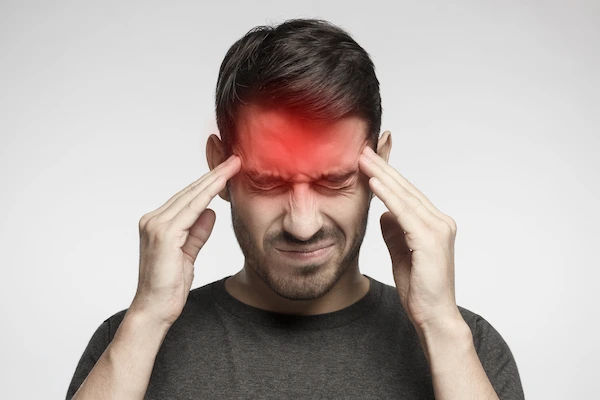What Really Triggers a Migraine Attack? The Chain Reaction Explained
Explore the biological chain reaction behind migraine attacks, uncovering how triggers set off pain and how understanding them can help you manage and prevent episodes.

Written by Dr. Siri Nallapu
Reviewed by Dr. Dhankecha Mayank Dineshbhai MBBS
Last updated on 29th Sep, 2025

Introduction: More Than Just a Bad Headache
A migraine attack is far more complex than a simple headache. It's a neurological event with distinct stages, often likened to a storm within the brain. For those who experience them, the question isn't just about pain relief, but about understanding the sequence of events: what leads to what? Why does a piece of chocolate or a change in the weather one day cause debilitating symptoms, while on another day, it doesn't? The answer lies in a precise, albeit unfortunate, biological chain reaction. This article will demystify that process. We'll move beyond a simple list of triggers and delve into the fascinating and often misunderstood pathway that starts with a subtle internal or external spark and culminates in the full-blown sensory assault of a migraine attack. By understanding this mechanism, you can gain a powerful sense of control and learn strategies to potentially intercept the process early. We will explore the hyperexcitable migraine brain, the domino effect of neurological and vascular changes, and how to identify your unique trigger profile.
The Migraine Brain: A Hyperexcitable Nervous System
At its core, a predisposition to migraine attacks begins with a brain that is inherently more sensitive to stimuli. Think of it as having a heightened alarm system. For most people, a bright light is just a bright light. For a migraine brain, that same light can be perceived as a threat, setting off a cascade of neurological events.
Genetics: The Primary Predisposition
Research strongly indicates that migraines often run in families. If one or both of your parents experience migraines, your likelihood of having them increases significantly. Specific gene variants affect how brain cells communicate, particularly their sensitivity to fluctuations in neurotransmitters like serotonin. This genetic setup creates the baseline hyperexcitability that makes the brain more susceptible to the triggers we will discuss later.
Cortical Spreading Depression: The Electrical Wave
This is a key player in the migraine attack, particularly for those who experience an aura. Cortical spreading depression (CSD) is a wave of electrical hyperactivity that spreads across the brain's surface (the cortex), followed by a period of suppressed activity. Imagine a pebble dropped in a pond, creating a rippling wave. This wave is thought to directly cause the visual disturbances, tingling, or speech difficulties of an aura. As the wave passes, it triggers changes in blood flow and activates the pain pathways, initiating the headache phase. Even in migraines without aura, a "silent" CSD is believed to occur deep within the brain.
Consult a Neurologist for the best advice
The Domino Effect: From Trigger to Full-Blown Attack
Understanding the hyperexcitable brain allows us to see how a trigger sets off a precise domino effect. Let's break down the stages of a migraine attack.
Phase 1: The Internal or External Trigger
A trigger is any factor that pushes the hyperexcitable brain past its threshold. This is highly individual. Common triggers include:
• Stress or the "let-down" period after stress.
• Hormonal fluctuations in women (e.g., around menstruation).
• Specific foods and drinks (aged cheese, processed meats, alcohol).
• Skipped meals or dehydration.
• Changes in sleep patterns.
• Sensory stimuli (bright lights, loud noises, strong smells).
• Weather changes.
Phase 2: The TriGeminal Nerve Activation
Once the brain is triggered, the wave of CSD (if it occurs) stimulates the trigeminal nerve. This is the largest pain nerve in the head, responsible for sensation in the face and meninges (the protective membranes covering the brain). Activation of the trigeminal nerve is a critical step in what causes a migraine to start. It releases a flood of neuropeptides, most notably CGRP (calcitonin gene-related peptide).
Phase 3: The Inflammatory Cascade and Pain
The release of CGRP and other substances causes intense inflammation and dilation (widening) of the blood vessels in the brain's covering. This combination—neurogenic inflammation and dilated blood vessels—puts pressure on the nerve endings, which is interpreted by the brain as severe, throbbing pain. This explains the classic, pulse-like quality of a migraine attack. This process also leads to increased sensitivity to light (photophobia), sound (phonophobia), and smell (osmophobia), as the entire nervous system is now on high alert.
Deconstructing Common Migraine Triggers
Now that we understand the chain reaction, let's see how specific triggers fit into this model.
Environmental Triggers (Light, Sound, Smell)
For a hyperexcitable brain, sensory input is a direct pathway to the trigeminal nerve. Fluorescent lighting or flickering screens can overstimulate the visual cortex, potentially initiating a CSD wave. Similarly, loud noises or strong perfumes can be perceived as threats, directly activating the brain's pain centers.
Hormonal Triggers (The Oestrogen Connection)
This is a primary reason women are more affected by migraines. A drop in oestrogen levels, such as right before a period, can affect serotonin levels and other neurotransmitters. Since serotonin helps regulate the trigeminal nerve's activity, an oestrogen drop can lower the threshold for nerve activation, making a migraine attack more likely. This is the basis for many hormonal migraine symptoms.
Dietary Triggers (Tyramine, Nitrates, and Additives)
Certain compounds in food can directly affect blood vessel diameter or neurotransmitter levels. Tyramine (in aged cheeses, cured meats) can cause vasoconstriction followed by rebound vasodilation. Nitrates (in processed meats) are converted to nitric oxide, a potent vasodilator. MSG can excite nerve cells. For a susceptible individual, these chemical changes can be the initial spark.
Lifestyle Triggers (Stress, Sleep, Dehydration)
Stress causes a release of cortisol and adrenaline, altering brain chemistry. The "weekend migraine" often occurs when stress levels drop suddenly. Irregular sleep disrupts the brain's homeostasis. Dehydration affects blood volume and electrolyte balance, impacting brain function. All these factors strain the nervous system, making it more vulnerable to crossing its migraine threshold.
Identifying Your Personal Trigger Profile
Because triggers are unique, the most powerful tool you have is a migraine diary. For 2-3 months, track:
1. Date and time of each attack.
2. Symptoms and their severity.
3. What you ate and drank 24 hours prior.
4. Your sleep schedule.
5. Stress levels.
6. For women: Your menstrual cycle phase.
7. Weather conditions.
Over time, patterns will emerge, revealing your personal migraine trigger foods to avoid or lifestyle factors to manage. If identifying your triggers feels overwhelming, consulting a neurologist online with Apollo24|7 can provide expert guidance in analysing your diary and developing a personalised management plan.
Conclusion
Understanding what leads to a migraine attack transforms it from a mysterious, punishing event into a biological process that can be studied and managed. While the genetic predisposition may be fixed, the chain of events that leads from a trigger to debilitating pain is where you can exert influence. By identifying your personal triggers through diligent tracking, you can learn to avoid the initial spark. By recognising the early warning signs of the prodrome phase, you can act quickly to potentially stop a migraine before it starts with prescribed acute medications. Most importantly, this knowledge reduces the fear and frustration that often accompany migraines. If your condition does not improve after trying these methods, booking a physical visit to a neurologist with Apollo24|7 can help you access advanced treatment options and take the next step toward reclaiming your life from migraines.
Consult a Neurologist for the best advice
Consult a Neurologist for the best advice

Dr Debnath Dwaipayan
Neurosurgeon
9 Years • MBBS, MS(Gen. Surgery), DrNB (Neurosurgery)
Delhi
Apollo Hospitals Indraprastha, Delhi

Dr. H Rahul
Neurologist
10 Years • MBBS, MD(Gen. Med.), DM(Neuro)
Secunderabad
Apollo Hospitals Secunderabad, Secunderabad
(100+ Patients)

Dr. Suresh P
Neurologist
9 Years • MD, DM(Neuro)
Madurai
Apollo Speciality Hospitals KK Nagar, Madurai
(25+ Patients)

Dr. Parthasarathy B
Neurologist
10 Years • MBBS, DNB(GENERAL MEDICINE), DM(NEUROLOGY)
Angamaly
Apollo Hospitals Karukutty, Angamaly
(100+ Patients)

Dr. Sathish Kumar V
Neurologist
16 Years • D.M Neurology (PGIMER, Chandigarh), • M.D General Medicine (GSVM Medical College, Kanpur )
Chennai
Apollo Speciality Hospitals OMR, Chennai
(200+ Patients)
Consult a Neurologist for the best advice

Dr Debnath Dwaipayan
Neurosurgeon
9 Years • MBBS, MS(Gen. Surgery), DrNB (Neurosurgery)
Delhi
Apollo Hospitals Indraprastha, Delhi

Dr. H Rahul
Neurologist
10 Years • MBBS, MD(Gen. Med.), DM(Neuro)
Secunderabad
Apollo Hospitals Secunderabad, Secunderabad
(100+ Patients)

Dr. Suresh P
Neurologist
9 Years • MD, DM(Neuro)
Madurai
Apollo Speciality Hospitals KK Nagar, Madurai
(25+ Patients)

Dr. Parthasarathy B
Neurologist
10 Years • MBBS, DNB(GENERAL MEDICINE), DM(NEUROLOGY)
Angamaly
Apollo Hospitals Karukutty, Angamaly
(100+ Patients)

Dr. Sathish Kumar V
Neurologist
16 Years • D.M Neurology (PGIMER, Chandigarh), • M.D General Medicine (GSVM Medical College, Kanpur )
Chennai
Apollo Speciality Hospitals OMR, Chennai
(200+ Patients)
More articles from Migraine
Frequently Asked Questions
1. Can you have a migraine aura without a headache?
Yes, this is known as a 'silent migraine' or acephalgic migraine. The electrical wave of Cortical Spreading Depression occurs, causing visual or sensory disturbances (aura), but it does not activate the trigeminal nerve to a degree that causes significant pain.
2. Why do some triggers only cause a migraine sometimes?
This is due to the 'threshold' concept. Your susceptibility is cumulative. If you're well-rested, hydrated, and stress-free, your threshold is high, and a single trigger like a glass of wine may not cause an attack. But if you're sleep-deprived and stressed, your threshold is low, and that same trigger can easily push you over the edge.
3. What are the best ways to stop a migraine when you feel it coming on?
Acting fast is key. At the first sign of a prodrome symptom (like yawning, mood changes, or neck stiffness), try to retreat to a quiet, dark room. Hydrate, apply a cold compress to your head or neck, and take your prescribed acute medication. Avoiding additional stimuli can sometimes help abort the attack.
4. Are there specific tests to confirm my migraine triggers?
There are no standard lab tests for most triggers. The gold standard is the migraine diary. However, if a food sensitivity is suspected, an elimination diet supervised by a doctor or dietitian can be very effective. Apollo24|7 offers convenient home collection for tests like a full blood count or vitamin panels, which can help rule out other conditions that might mimic or exacerbate migraines.
5. How can I tell the difference between a migraine and a tension-type headache?
Migraine pain is typically moderate to severe, throbbing, and often on one side of the head. It's aggravated by activity and accompanied by nausea, vomiting, and/or sensitivity to light and sound. Tension-type headaches are usually a constant, dull, band-like pressure around both sides of the head without the associated neurological symptoms.




